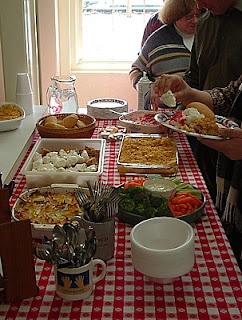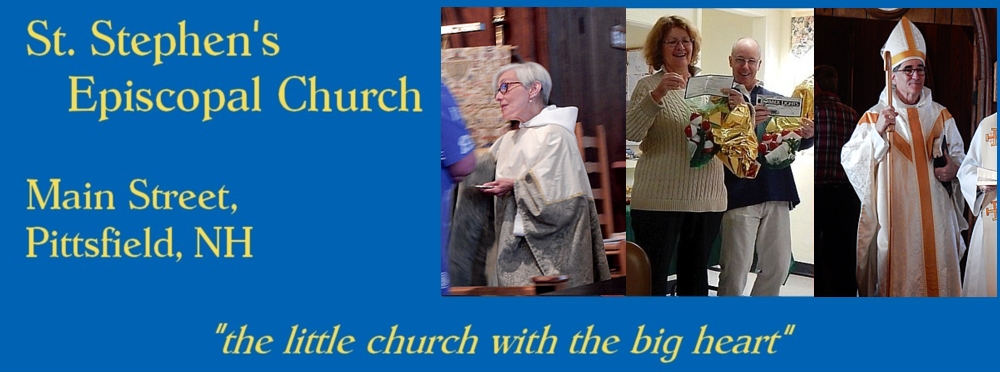Lent IV: Year CJoshua 4:19-24; 5: 9-12
Psalm 34
2 Cor 5:17-21
Luke 15: 11-32Remember last week when I talked about Moses and the burning bush that kept on burning without consuming the wood, and how any Yankee would love that?! Well, there I was last night, feeding the fire at my parents home and enjoying the dance of the flames, and wishing I wouldn’t have to get up and feed the fire. Too bad they don’t have burning bush at Home Depot! Well, to coin my own Yankee truism, having a relationship with God is like tending a fire--you have to keep choppin’, haulin’, pokin’ and proddin’, and most of all, feedin’. So today I want to talk to you some more about feedin’ the fire. Unfortunately, after the Nor’easter on Friday, it’s something we are still too intimately concerned with!
In my office on my computer monitor I have a little bookmark taped with the words:
Christ be with me, Christ within me, Christ behind me, Christ before me,
Christ beside me, Christ to win me, Christ to comfort and restore me
Christ beneath me, Christ above me, Christ in quiet, Christ in danger,
Christ in hearts of all that love me, Christ in mouth of friend and stranger.This is, of course, from the hymn called St. Patrick’s Breastplate, because the words are attributed to St. Patrick. It begins with the great line, “I bind unto myself today the strong name of the Trinity.” It is rather nice to quote from this hymn the day after St. Patrick’s Day, but it lends itself nicely to a theme I want to build with the Scriptures today. That theme is Reconciliation. When we are about the business of reconciliation, we are tending the fire.
When you read the Christian Scriptures, especially Paul’s letters, you become very aware of how Paul and the early Christians saw their role in spreading the Gospel as one of reconciliation. Over and over again, Paul writes and ministers to congregations and communities with the underlying theme of making peace with each other and with God--and especially how you do this through following Christ. This is very powerfully said in the 2 Corinthians passage when Paul says, “All this is from God, who reconciled us to himself through Christ, and has given us the ministry of reconciliation; that is, in Christ God was reconciling the world to himself, not counting their trespasses against them, and entrusting the message of reconciliation to us.” We make so much out of the death and resurrection of Jesus as the way to eternal life, but do you think about it in terms of reconciliation?
Again, building on the Lenten discipline I have been elaborating on the last several weeks, if we think of accepting Jesus or becoming a Christian as just a ticket to heaven, then we really haven’t gone deep enough. So far I have talked about contemplative or centering prayer as a way to begin to find that peace with God. I told you the story of my experience in a monastery years ago and how profoundly that centering prayer confronted me and required me to identify those things that kept me from God. It was in the practice of that prayer that those things became so self-evident. My ‘repenting’ of them, or turning away from them, was all about the desire then to be reconciled.
Last week I talked about Moses and the burning bush and how God, the great I AM, calls us into relationship from which flows an essential reconciliation process. There is something about the walk with God that calls us into being all we were meant to be--in essence, to be reconciled with our true selves. Have you been on this path this Lent? Have you found odd little moments in your work-a-day world to pause and find your center--to be reconciled with yourself and God.
But that is not where it ends of course. We are not on a journey to find some blissful state and let it go at that. We are a people that live out our reconciliation with God in the world. Indeed, we are called to proclaim our reconciling God--to share the Good News. In this passage from Corinthians, Paul goes on to say that, “We are ambassadors for Christ, since God is making his appeal through us; we entreat you on behalf of Christ, be reconciled to God.”
Wow, have you ever thought of yourself as an ambassador? What good are we as ambassadors if we don’t know the culture, people, laws, and the joys of the country from which we come? And of course Christ is the country from which we come, and our brothers and sisters are the people. Are we reconciled with him and with them? The St. Patrick’s Breastplate is my little reminder always to be longing to be intimately connected with Christ: Christ within, behind, above, before, beside, in quiet, in danger ... and ah, this great line, “Christ in mouth of friend and stranger.” St. Patrick knew the importance of the reconciling ministry particularly in the witness of this line--he looked for Christ in all who he came across. Now truth be told, sometimes it is a lot easier to see Christ in the stranger, and much more difficult to see Christ in a family member with whom we seem to have constant tension or bickering. Yet this is what we are called to see.

Erich Fromm, a psychologist and Christian, in his book “The Art of Loving: An Inquiry into the Nature of Love,” writes of this kind of reconciliation and centeredness when he writes about all the types of love and how they are formed and manifested. In a section called Brotherly Love he writes this:
If I have developed the capacity for love, then I cannot help loving my brothers. In brotherly love there is the experience of union with all men, of human solidarity, of human at-onement. Brotherly love is based on the experience that we all are one. The differences in talents, intelligence, knowledge are negligible in comparison with the identity of the human core common to all men. In order to experience this identity it is necessary to penetrate from the periphery to the core. If I perceive in another person mainly the surface, I perceive mainly the differences, that which separates us. If I penetrate to the core, I perceive our identity , the fact of our brotherhood. This relatedness from center to center—instead of that from periphery to periphery--is “central relatedness.”(The Art of Loving, Erich Fromm, Harper and Row, NY, 1956, p. 47)In this passage I think that Fromm gets the essential lesson of reconciliation when he says that “Brotherly love is based on the experience that we all are one.” When we can really fully appreciate that, then there is no option but to pursue reconciliation.
In the Gospel lesson today, the well-known parable of the prodigal son, we see this theme of reconciliation developed beautifully in the context of family: the prodigal son, who comes home begging forgiveness and asking only to be treated as a servant, is reconciled to his father who celebrates his homecoming. This of course mirrors our relationship with our loving God from whom we seem to stray too often.
It might be worth a little Lenten meditation to spend some time thinking about who you identify with in this parable: the prodigal son, the father, or the good son, or maybe at different times all three! I think too often I relate to the good son and I struggle to find forgiveness and reconciliation in my heart.
Soon we will be celebrating the Eucharist. One way of looking at the Eucharist is a weekly celebration of reconciliation, because in the prayer we recite how God, through Christ, brings us to reconciliation. In fact in the first Eucharistic prayer in Rite II after the Sanctus, the prayer begins, “Holy and Gracious Father: In your infinite love you made us for yourself; and , when we had fallen into sin and become subject to evil and death, you, in your mercy, sent Jesus Christ, your only and eternal Son, to share our human nature, to live and die as one of us, to reconcile us to you, the God and Father of all.
The seriousness about Holy Communion is about the desire to be reconciled with God and our brothers. If you have no intention of being reconciled, why bother coming?
Clearly our world needs reconciliation. Our church is in the midst of trying times that challenge the spirit of reconciliation. Iraq grinds on and the need for reconciliation between Shiite, Sunni, and Kurd is all too apparent. One of the most profound and simple things I heard in this war was from a US General who simply said that the bloodshed would cease when Shiite and Sunni decided they loved their children more than they hated their enemies. Let us pray that more Iraqis quickly see the wisdom of that.
Now I’ve talked a lot here about some ideas and concepts and it might have been just a bit too much. I‘m reminded of the not-too-clever music critic when, after hearing a new symphony, responded, “It was OK, but there were too many notes!” And maybe I’ve just had a few too many "words"! So I want to leave you with something a bit more concrete, something I call a "feeling image." My feeling image for reconciliation can be something like last Friday night being holed up at home with family safe, food in the cupboard, and feeling safe and warm as the snow storm howled around you. This is the sense of being centered and at peace. But one more touch is necessary—-a candle in the window for the stranger. This may be a bit too passive of an image for reconciliation, but it seems to capture for me, an attitude of the heart that allows us to be reconcilers.
The other image I want to share with you is a tangible one [pass around the new dollar coin]. I’m sure that preachers all across the country are making hay with this and I just couldn’t resist. The new coin has been in the news recently because the phrase “In God We Trust” that is engraved on the side of the coin was missing from some of the early editions. This too is an image of being a reconciler--having “In God We Trust” engraved all around us. Sometimes it gets rubbed off or goes missing from our reconciling efforts, yet one can never get far in the work of reconciliation without that trusting relationship with God surrounding all that we do.
So, I hoped I’ve stoked your fires a little and encouraged you to tend your fire that will warm and brighten the spirit of reconciliation in you. But remember, I might blow on the flame a little, but you have to tend the fire every day. As we come to the altar, let’s recommit ourselves to a Lenten dedication to reconciliation.










